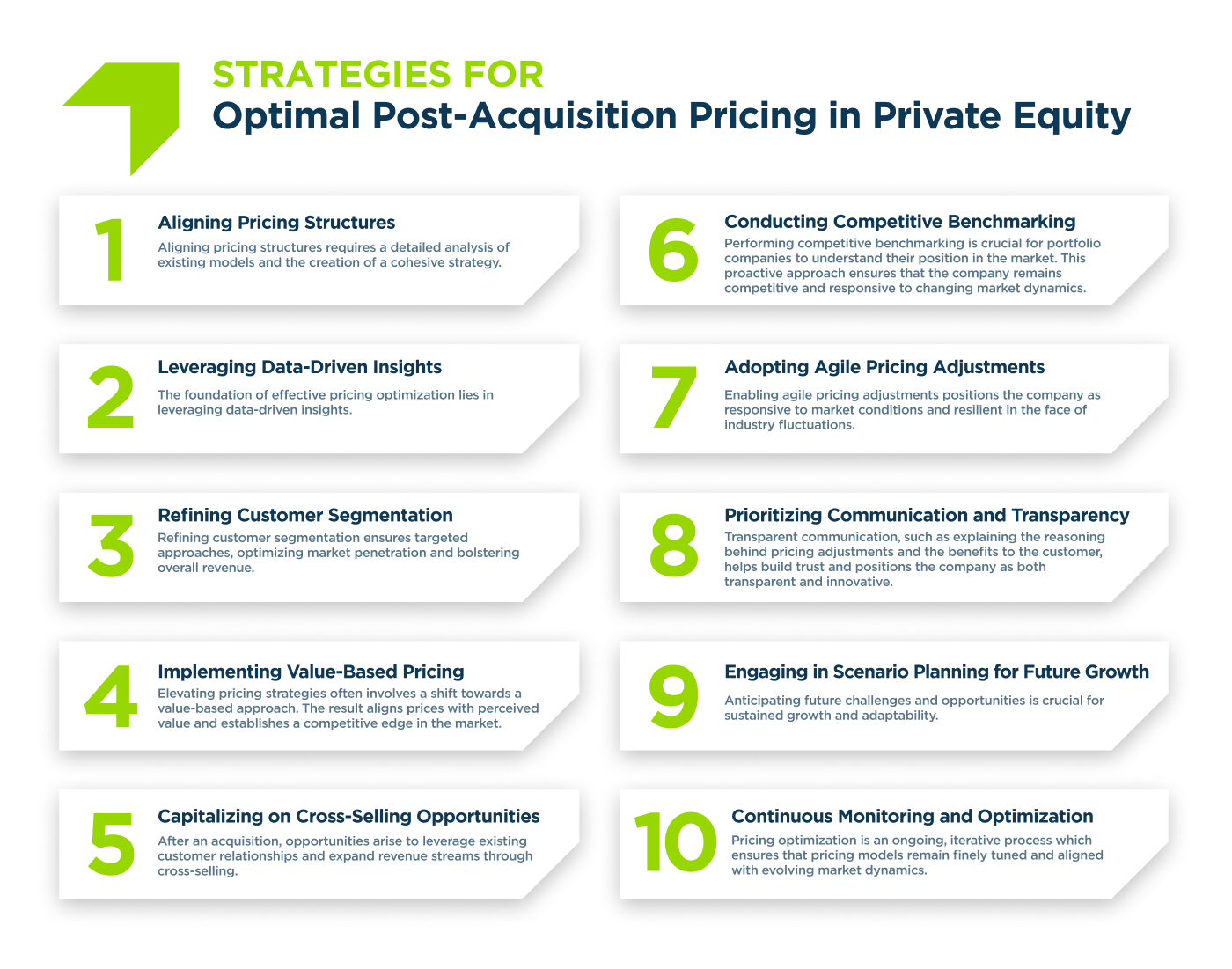In the dynamic realm of private equity, where each investment decision shapes the trajectory of success, the art of post-acquisition pricing optimization emerges as a pivotal component among other strategic maneuvers. Beyond the initial transaction, it is the careful orchestration of pricing strategies, alongside operational enhancements, talent management, and market positioning, that truly defines the value creation journey. In this exploration, we delve into the intricacies of post-acquisition pricing optimization, offering actionable insights and real-world examples to empower private equity firms in maximizing the value of their portfolio companies.
1. Aligning Pricing Structures:
Private equity firms often encounter the challenge of reconciling disparate pricing structures when integrating a portfolio company. In practice, this involves a meticulous examination of the pricing model, followed by the development of a unified strategy. For example, after acquiring a software company specializing in subscription-based services, a private equity firm might harmonize pricing structures by streamlining subscription tiers and introducing value-added features to enhance customer value proposition.
2. Leveraging Data-Driven Insights:
The foundation of effective pricing optimization lies in leveraging data-driven insights. Consider a healthcare services acquisition, where consolidating data provides a comprehensive understanding of patient behaviors and service utilization patterns. With these insights, the portfolio company can adjust pricing strategies based on factors such as patient demographics, treatment outcomes, and reimbursement rates, ensuring optimal revenue generation while maintaining high-quality care standards.
3. Refining Customer Segmentation:
In the aftermath of an acquisition, refining customer segmentation is essential. Take, for instance, a consumer goods company. Through a rigorous analysis of customer demographics and purchasing behaviors, private equity firms can tailor pricing strategies to align with the distinct needs of various customer segments. This refinement ensures targeted approaches, optimizing market penetration and bolstering overall revenue.
4. Implementing Value-Based Pricing:
Elevating pricing strategies often involves a shift towards a value-based approach. For example, if a private equity firm acquires a technology company known for innovation, the portfolio company may transition from cost-based pricing to value-based pricing to reflect the added benefits and competitive advantages of its products or services. This not only aligns prices with perceived value but also establishes a competitive edge in the market.
5. Capitalizing on Cross-Selling Opportunities:
After an acquisition, opportunities arise to leverage existing customer relationships and expand revenue streams through cross-selling. In the case of a retail chain, complementary products within the portfolio can be cross-promoted to existing customers using customer purchase history and preferences. This cross-selling strategy not only increases average transaction value, but also enhances customer satisfaction and loyalty by offering a more comprehensive solution.
6. Conducting Competitive Benchmarking:
Portfolio companies must stay attuned to the competitive landscape. In practice, this involves rigorous competitive benchmarking to assess pricing strategies, product offerings, and customer experiences relative to key competitors. For example, in the case of a software company, regular pricing audits and market analyses help identify pricing gaps and opportunities for differentiation. This proactive approach ensures that the company remains competitive and responsive to changing market dynamics.
7. Adopting Agile Pricing Adjustments:
Enabling agile pricing adjustments affords a portfolio company to swiftly respond to the market. For instance, the manufacturing industry is often influenced by fluctuating material costs. Dynamic pricing allows the portfolio company to adjust prices promptly, ensuring competitiveness, and capitalizing on emerging opportunities or mitigating potential risks in the manufacturing landscape. This agility positions the company as responsive to market conditions and resilient in the face of industry fluctuations.
8. Prioritizing Communication and Transparency:
Transparent communication helps build customer trust. For example, a technology solutions portfolio company may choose to increase its investment in research and development to unlock enhanced cybersecurity measures. By explaining this as the ‘why’ behind a pricing adjustment, and how these enhanced measures will improve the customer experience well beyond the increase, the company is positioning itself as both transparent and innovative.
9. Engaging in Scenario Planning for Future Growth:
Anticipating future challenges and opportunities is integral. In a scenario where a private equity firm acquires a renewable energy company, proactive scenario planning involves modeling different pricing scenarios based on potential changes in energy policies and market dynamics. This forward-thinking approach positions the portfolio company for sustained growth and adaptability in a dynamic market, where regulatory changes and technological advancements play a pivotal role in shaping the industry landscape.
10. Continuous Monitoring and Optimization:
Pricing optimization is an ongoing, iterative process. In the context of a newly acquired digital marketing agency, continuous monitoring may involve regular assessments of customer feedback, analysis of campaign performance, and the utilization of real-time market data to make informed pricing decisions. This ensures that pricing models remain finely tuned and aligned with evolving market dynamics.
Conclusion:
Navigating the complexities of post-acquisition pricing optimization demands a business professional’s acumen—a strategic and calculated approach that goes beyond numerical adjustments. By aligning structures, leveraging data-driven insights, and embracing adaptability, private equity-backed portfolio companies can optimize pricing strategies for sustainable growth and enhanced profitability. This commitment to transparency and ongoing optimization ensures a seamless transition and fosters long-term success in the newly formed entity.
Embarking on the journey of post-acquisition pricing optimization is not just a strategic choice; it is a decisive imperative for business excellence. If your organization is currently navigating the challenges of a recent merger or acquisition and seeks expert guidance to unlock the full potential of pricing strategies, our seasoned team of private equity pricing experts is poised to assist. Contact Cortado Group today to explore tailored solutions that will not only optimize your pricing but also position your newly integrated entity for sustained success in the dynamic market landscape.




